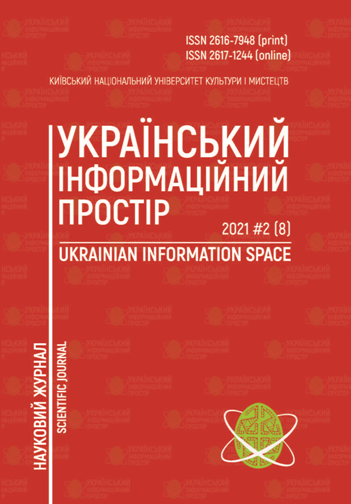Рейтинг університету як інструмент оцінювання якості освіти
DOI:
https://doi.org/10.31866/2616-7948.2(8).2021.245787Ключові слова:
міжнародні рейтинги університетів, показники та індикатори рейтингування, навчальні заклади, якість освіти, університет «світового класу»Анотація
Мета статті полягає в комплексному аналізі методології рейтингування провідних міжнародних та європейських рейтингів університетів. Методологія дослідження ґрунтується на застосуванні методів абстрагування, аналізу й синтезу, що дало змогу теоретично осмислити явище рейтингування університетів світу. Наукова новизна одержаних результатів полягає в розробці пропозицій з удосконалення міжнародних рейтингів університетів.
На підставі аналізу показників, індикаторів і вагових коефіцієнтів найбільш впливових міжнародних рейтингів університетів світу (ARWU, THE, QS World University Rankings, Webometrics, PRSP, CWTS Leiden Ranking, SCImago Institutions Rankings, U-Multirank) констатовано, що склад їх показників варіюється в межах відносно невеликої кількості ключових ознак, вибір яких пов’язаний із мірою доступності даних для аналізу та суб’єктивною позицією розробників щодо першорядних характеристик університету. Зроблено висновок, що рейтингові показники не враховують специфіку організації освітнього, наукового та інноваційного процесів в університеті.
У методологіях рейтингування відсутні індикатори, що характеризували б процесс навчання, якість викладання, успішність студентів, міру сформованості їх вміння вчитися та самостійно здобувати нове знання, якщо йдеться про міжнародні рейтинги, і готовність випускників до професійної діяльності в конкретному соціальному контексті конкретної країни, якщо йдеться про національні рейтинги. Наголошено, що маркетинговий механізм оцінювання університетів повинен бути доповнений гуманістичним, який передбачає розуміння процесу навчання як взаємодію студента, викладача й оточуючого середовища. При розробці рейтингів варто чітко визначитися з набором показників для різних за профілем підготовки університетів, обґрунтувати індикатори, їх вагові коефіцієнти та методи підрахунку інтегрального показника.
Посилання
Aguillo, I. F. (2021). Methodology. Ranking Web of Universities. https://www.webometrics.info/en/Methodology [in English].
Altbach, P. G., & Hazelkorn, E. (2017). Pursuing Rankings in the Age of Massification: For Most-Forget About It. International Higher Education, 89, 8–10. https://doi.org/10.6017/ihe.2017.89.9834 [in English].
Altbach, P. G., & Peterson, P. M. (2007). Higher Education in the New Century: Global Challenges and Innovative Ideas. UNESCO. https://doi.org/10.1163/9789087903169_001 [in English].
Altbach, P. G., Reisberg, L., & Rumbley, L. E. (2010). Trends in Global Higher Education: Tracking an Academic Revolution. UNESCO [in English].
Carey, K. (2006, September 22). College Rankings Reformed: The Case for a New Order in Higher Education. Eric. https://eric.ed.gov/?id=ED502114 [in English].
Cohen, D. (2001, August 1). Asiaweek Cancels Controversial University Survey. The Guardian. https://www.theguardian.com/education/2001/aug/01/highereducation.uk [in English].
Federkeil, G. (2008). Ranking and Quality Assurance in Higher Education. Higher Education in Europe, 33(2–3), 219–231. https://doi.org/10.1080/03797720802254023 [in English].
Hazelcorn, E. (2011). Ranking and the Reshaping of Higher Education: The Battle for World-Class Excellence. Palgrave Macmillan [in English].
Indicators. (n.d.). NTU Ranking. http://nturanking.csti.tw/methodoloyg/indicators [in English].
IREG Inventory on International Rankings. (n.d.a). IREG Observatory on Academic Ranking and Excellence. https://ireg-observatory.org/en/initiatives/ireginventory-of-international-rankings/ [in English].
IREG Inventory on National Rankings. (n.d.b). IREG Observatory on Academic Ranking and Excellence. https://ireg-observatory.org/en/initiatives/ireginventory-of-national-rankings/ [in English].
Kabinet Ministriv Ukrainy. (2018, March 14). Pro zatverdzhennia pereliku svitovykh reitynhiv universytetiv dlia vyznachennia osoblyvoi katehorii inozemtsiv ta osib bez hromadianstva, yaki pretenduiut na pratsevlashtuvannia v Ukraini: Rozporiadzhennia [On Approval of the List of World Rankings of Universities to Determine a Special Category of Foreigners and Stateless Persons Applying for Employment in Ukraine: Order] (№ 154-r). https://zakon.rada.gov.ua/laws/show/154–2018-%D1%80#Text [in Ukrainian].
Kong, L. (1999). Asian Higher Education and the Politics of Identity. Environment and Planning A, 31, 1525–1528. https://doi.org/10.1068/a311525 [in English].
Marginson, S. & Wende, M. van der (2007). To Rank or To Be Ranked: The Impact of Global Rankings in Higher Education. Journal of Studies in International Education, 11(3–4). https://doi.org/10.1177/1028315307303544 [in English].
Marginson, S. (2014). University Rankings and Social Science. European Journal of Education, 49(1), 45–59. https://doi.org/10.1111/ejed.12061 [in English].
McCormic, A. (2008). The Complex Interplay Between Classification and Ranking of Colleges and Universities: Should the Berlin Principles Apply Equally to Classification? Higher Education in Europe, 33(2–3), 209–218. https://doi.org/10.1080/03797720802253744 [in English].
Merisotis, J., & Sadlak, J. (2006, May 30). International Partnership Issues Groundbreaking Principles on Ranking of Higher Education Institutions. http://200.6.99.248/~bru487cl/files/Berlin_Principles_Release.pdf [in English].
Parkhomenko, N. O. (2020). Vplyv mizhnarodnykh reitynhiv na konkurentospromozhnist zakladiv vyshchoi osvity [Impact of International Rankings on the Competitiveness of Higher Education Institutions]. Efektyvna ekonomika, 3. https://doi.org/10.32702/2307–2105–2020.3.76 [in Ukrainian].
QS Audience. (n.d.). QS. https://www.qs.com/press-room/ [in English].
Ranking Methodology. (n.d.). Scimago Institutions Rankings. https://www.scimagoir.com/methodology.php [in English].
Rankings Methodology. (n.d.). QS. https://www.qs.com/rankings/ [in English].
Roehampton Ranked in Top 10 Universities in London. (2018, September 21). University of Roehampton. https://www.roehampton.ac.uk/news/2018/september/roehampton-ranked-in-top-10-universities-in-london/ [in English].
Sacks, P. (2011). America’s Best College Scam. HuffPost. https://www.huffpost.com/entry/americas-best-college-sca_b_45064 [in English].
Salmi, J. (2009). The Challenge of Establishing World-Class Universities. The World Bank [in English].
Shanghai Ranking’s. (n.d.). Home. https://www.shanghairanking.com [in English].
ShanghaiRanking’s Academic Ranking of World Universities Methodology 2020. (n.d.). ShanghaiRanking. https://www.shanghairanking.com/methodology/arwu/2020 [in English].
Tatarinov, I. Ye., & Herasymov, O. V. (2013). Svitova praktyka formuvannia reitynhiv universytetiv: vyznachennia naibilsh obiektyvnykh kryteriiv ta indykatoriv otsiniuvannia [International Experience in Universities Ratings Formation: Most Objective Criteria and Assessing Indicators Determination]. Ukrainian Society, 1(44), 100–116 [in Ukrainian].
U.S. News & World Report. (2021, 15 November). In Wikipedia. https://en.wikipedia.org/wiki/U.S._News_%26_World_Report [in English].
Web of Science. (2021, 18 November). In Wikipedia. https://en.wikipedia.org/wiki/Web_of_Science [in English].
World Universities Insights Limited. (2021, August 26). World University Rankings 2022: Methodology. World University Rankings. https://www.timeshighereducation.com/world-university-rankings/world-university-rankings-2022-methodology [in English].
World University Rankings By 2021. (n.d.). NTU Ranking. http://nturanking.csti.tw/ranking/OverallRanking/ [in English].
##submission.downloads##
Опубліковано
Як цитувати
Номер
Розділ
Ліцензія
Авторське право (c) 2021 Михайло Поплавський

Ця робота ліцензується відповідно до Creative Commons Attribution 4.0 International License.
The authors retain copyrights to the work and at the same time grant the journal the right to first publish it under the terms of the Creative Commons Attribution License, which allows other persons to freely distribute the published work with a mandatory reference to its authors and its first publication.
The journal allows the author(s) to hold the copyright without restrictions and to retain publishing rights without restrictions.
The author of the published article has the right to distribute information about it and to post references to work in the electronic repository of the institution.




